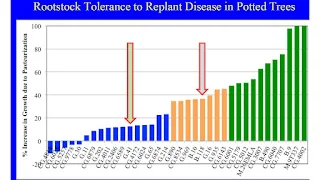 |
| The in-ground portion of the rootstock is Bud 118. This tree was planted in a site that previously hosted a peach tree. |
It exhibited "failure to thrive" syndrome for the last two years.
Its siblings, same rootstock (Bud-118), interstem (G.935) and scion (Novaspy) are seven feet tall and show about thirty fruiting spurs each. The terminal side shoots show an average of 24" of growth for the season.
The failure is about 40" tall. The two highest terminal shoots died back. The lower ones petered out after about 6".
The leaves showed symptoms similar to magnesium deficiency. A foliar application of Epson Salts (magnesium sulfate) did not remedy the situation.
Today I ripped out the plant.
 |
| I found new young roots attempting to extend from the core root. This is the opposite of a virtuous cycle. The puny top growth does not produce enough carbohydrates for overwhelming root growth. |
 |
| I found dead roots. Lots of dead roots. Dead roots are not very efficient at picking up nutrients or water. |
 |
| And there were some live roots with what appear to be dead (necrotic) regions on them. |
 |
| Results of greenhouse testing shows Bud-118 as having intermediate resistance to replant complex. G-41 shows resistance to replant complex AND has good resistance to Wooly Apple Aphid. |
I hope I removed Typhoid Mary before she had a chance to share with neighboring trees.
No comments:
Post a Comment
Readers who are willing to comment make this a better blog. Civil dialog is a valuable thing.